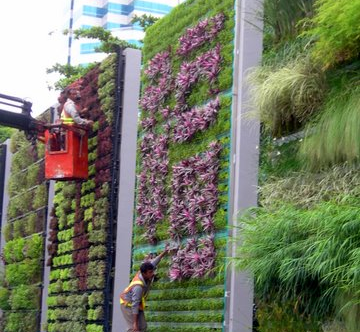Vertical Gardens - Good for You, Good for the Planet
What The Guardian called 'The Urban Green Revolution' is a growing movement. Green areas are popping up all over cities, in balconies, roof gardens and more. But why do green areas need to be flat?
This is where vertical gardens come into play. A vertical garden can be grown directly up a wall, hanging vertically. This isn't just the usual creeping plants like ivy that grow up walls though, these are entire gardens of various plants suspended on walls while causing no damage to the underlying structure.
Not only do vertical gardens help the environment, they also make buildings more economical. A building with vertical gardens on its walls will stay cooler in summer and warmer in winter, saving money on air conditioning and heating. Not only that, but businesses with vertical gardens tend to get more customers, and vertical gardens also improve mental health and reduce stress considerably.

One creative type of vertical garden is a plant wall. A plant wall is usually planted on a frame, which is then attached to the wall. This is so that it is easier to remove it in the future, and also to prevent damage to the wall. The frame should be made of plastic - PVC pipes are a good option. You should avoid using metal or wood for the frame, as metal increases the weight and wood can rot.

Next, a layer of plastic sheeting is spread tightly across the frame. This stops water from getting trapped behind the frame and causing damage to the walls. After that, you should spread a layer of fabric across the frame. This is what your plants will grow in, and it's very important that it is stretched taught across the frame without any creases, like a canvas. Any material that can hold water without rotting can be used for this and you will likely need at least two layers of fabric.
Next, you need to create a way to water your plants. This will basically consist of a pipe running along the top of the frame, with regular holes to allow water into the fabric. You should attach a valve that you can set to open water for only short bursts, and set this to go off a few times a day. It is important to capture the balance between keeping the fabric damp and avoiding over-watering your plants. You will also want to attach a liquid fertilizer system to this, as that is the only way for your plants to get nutrients.
Now it's time to plant! You will need to be careful, choosing which plants to use based on sunlight, humidity, temperature and wind, as well as other factors. For a vertical garden you should use plants that can survive in places colder than where the garden in located, as it is harder for plants to survive in a vertical garden. To attach the plants, simply make a small cut in the fabric, clean the roots of the plant you want to attach (this prevents root rot), and then insert the root bundle into the cut. Staple the fabric into the plastic sheeting in a semi-circle to make an envelope to hold the plant securely. This may seem like a lot of work to some people, however there are other options. Artificial plant walls are available, and they can look just as good as the real thing.
Another type of vertical garden can be built using potted plants. You can use any ordinary potted plants for this type of system. One option when using potted plants to create a vertical garden is to attach them directly to a wall. This can be done in a number of different ways. One method is to create a cradle to place the pots in, and then hang these from a wall, similar to a hanging basket. Another option is to create wall brackets for terracotta pots, and attach these to a wall.

A third, and in my opinion the most attractive option, is to use metal pots. The advantage of using metal pots is that holes can be safely drilled into them, allowing them to be screwed directly into a wall. It is important to note that you should not attempt to attach terracotta pots directly to a wall, as they will break and possibly cause damage to the wall.
So what are you waiting for? Beautify your building with a vertical garden and start experiencing the benefits today!
George is an avid gardener and the content editor of BuildMat. He is an expert in indoor plants and urban gardening methods.
Vertical wall image by Huib Sneep (http://www.greenwavesystems.nl) [CC BY-SA 3.0 ], via Wikimedia Commons
Plant wall image by David Aldous (Sent to me personally by email) [CC BY-SA 3.0 ], via Wikimedia Commons
Want more from Gardenzine? Search Gardenzine for articles here:






